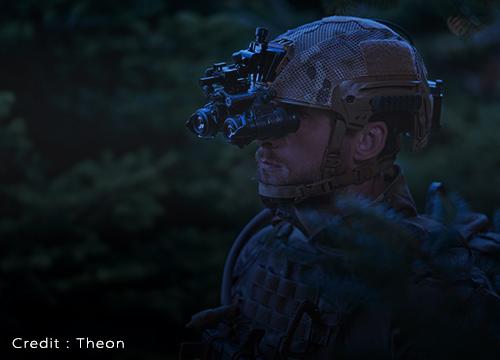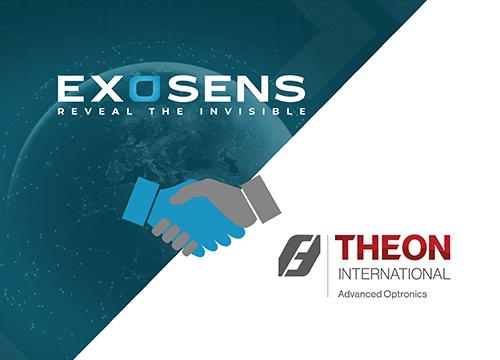Overcoming the technical challenges of single photon detection
Contents:
The need for single photon detection rechnology
Vacuum tube detectors: how they work
Vacuum tube detector benefits
Reliability and lifetime
Pricing
The photonis solution
Frequently asked questions (FAQs)
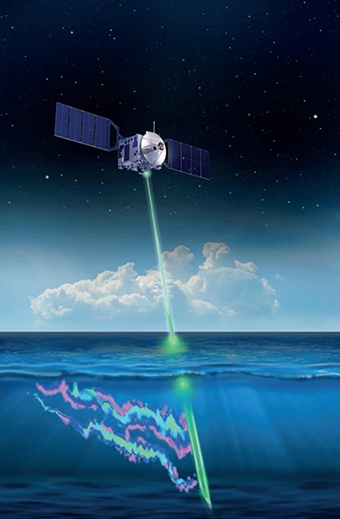
Human beings’ natural desire to better understand the behavior in the world around us brought us the research field of quantum optics; the study of nature and effects of light as quantized photons. The rapidly evolving world of quantum optics has created a demand for a new generation of high performance detectors that can accurately and efficiently detect light signals down to the singular photon.
These detectors are essential for applications and research fields such as: High-End LIDAR, Quantum Optics, Quantum Telecommunication, High Energy Physics, Particle Physics, Nuclear Physics, Fluorescence Imaging, Astronomy, Plasma Research and many others. The ability to detect individual photons with high precision and efficiency is paramount for advancing these fields.
The need for single photon detection technology
Single photon detection and imaging technologies are an area of intense and continuing interest. The rapidly evolving field of research represents the bridge between our daily experience within the visible light spectrum, and the quantum realm where we may access low-level light signal down to the singular photon.
Applications such as those mentioned above present strict engineering requirements, such as high photon detection efficiency, low dark-count rate, sensitivity in the IR-spectrum, and instrument-limited time jitter. These applications and their requirements have together motivated research and development efforts for single-photon detectors.
Common types of single photon detection technologies include Avalanche Photodiodes (APDs), Single Photon Avalanche Diodes (SPADs), Transition-Edge Sensors, Single Electron Transistor Detectors (SET), Superconducting Nanowire Single Photon Detectors (SNSPDs), and Vacuum Tube-Based Photon Detectors. More information on the varieties of single photon detectors is available here. While many types of detectors exist, vacuum tube-detectors set themselves apart with their ability to operate in a wide range of temperature conditions, their high detection efficiency, and their relatively inexpensive pricing.
Vacuum tube detectors: how they work
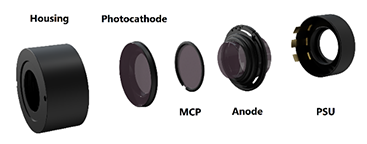
Vacuum tube-based Image Intensifier Tubes are best known for their use in night vision goggles used in military applications. The same technology can also be used to build highly sensitive detection solutions for low light level imaging and single photon counting.
Key components and functions
Vacuum tube-based Image Intensifier tubes consist of several essential components; a Photocathode, a Microchannel Plate (MCP) and an anode. These components work together to amplify input signal, creating a rich and dynamic output.
Principles of operation
In the first step, existing ambient light passes through a photocathode, which converts the incoming photon signal into a photo-electron.
In the second step, photoelectrons are drawn by an electrical field into the MCP where they impinge multiple times on the inner walls and thereby multiply several thousands of times. In photon counting applications the multiplied electron signal is detected using an anode. In the instance of photon imaging applications, the anode converts the electron back into photons to produce an image.
To further visualize how an image intensifier tube works, click here to watch a demonstration of Cricket™2 an advanced image intensifier adapter for single photon and low light level imaging.
Vacuum tube detector benefits
A major benefit of vacuum tube based single photon detectors is their high detection efficiency. The pro
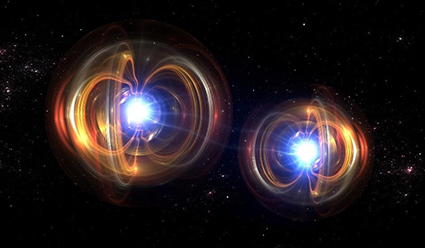
perties of the thin photosensitive layer (photocathode) inside the vacuum allow for extreme low dark count rates combined with market leading quantum efficiency.
The quality of the vacuum and parts in the vacuum make after pulsing nearly non-existent. This results in high detection efficiency of single photons, which makes it possible to detect and measure extremely weak light signals.
An additional benefit of vacuum tube-based photon detectors is their low noise operation. The gated mode of operation (extreme fast electronic shutter) allows the photocathode to be active only for a short period of time, reducing the number of false counts generated by dark counts and after pulsing. This makes it possible to accurately detect and measure weak light signals in a wide range of scientific and industrial applications.
-------------------------------------------------------------------------------------------------
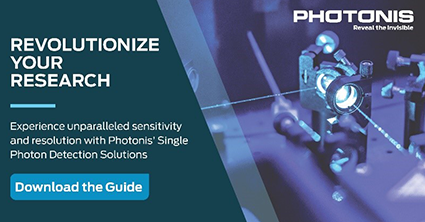
-------------------------------------------------------------------------------------------------
Reliability and lifetime
An advantage of vacuum tube-based single photon detectors is their ability to operate within a wide range of temperatures and in extreme environments. The Extreme High Vacuum (XHV) inside the tube helps to protect the photocathode from damage, which results in an extended lifetime of the detector. This makes vacuum tube based single photon detectors an ideal choice for use in harsh environments and for long-term measurements.
Pricing
In addition to performance benefits, vacuum tube-based single photon detectors can be relatively less expensive to produce than other types of single photon detectors. Their long lifetime benefits coupled with their low cost make vacuum tube-based detectors an ideal candidate for single photon detection and imaging techniques. As such, these detectors are more accessible to a wide range of users and in a variety of applications.
The Photonis solution
Photonis offers state of the art vacuum tube detector technology, delivering advanced solutions for a new generation of high-performance photon detectors. Their use in Quantum Optics allows us to REVEAL THE INVISIBLE in the world around us!
Photonis proposed various types of high-sensitivity, fast-timing, low-noise, vacuum tube-based single photon detectors for OEM and end-user applications. Our team of experts provide support and consulting services to help select and implement the right single photon detector for all applications, from Space to Quantum Telecommunications, and many others.
Photonis multialkali Hi-QE photocathode technology combines a high quantum efficiency (QE) in the 120-1050 nm spectral range, with a dark count rate as low as 50 Hz/cm², thereby achieving a superb signal to noise ratio. When the photocathode is utilized as an ultra-fast electro-optical shutter, sub nanosecond (billionth of a second) gating speeds can be achieved for accurate transient phenomena imaging.
-------------------------------------------------------------------------------------------------
To learn more about Photonis' current single photon counting and imaging technology, visit the page:
-------------------------------------------------------------------------------------------------
Frequently asked questions (FAQs)
How do vacuum tube-based detectors work?
Vacuum tube-based Image Intensifier tubes consist of several essential components; a Photocathode, a Microchannel Plate (MCP) and an anode. These components work together to amplify input signal, creating a rich and dynamic output.
In the first step, existing ambient light passes through a photocathode, which converts the incoming photon signal into a photo-electron.
In the second step, photoelectrons are drawn by an electrical field into the MCP where they impinge multiple times on the inner walls and thereby multiply several thousands of times. In photon counting applications the multiplied electron signal is detected using an anode. In the instance of photon imaging applications, the anode converts the electron back into photons to produce an image.
What are the main benefits of vacuum tube-based detectors?
Vacuum tube-based single photon detectors offer several benefits for single photon detection applications compared to other technologies.
Here are some of the main advantages:
- High sensitivity: Vacuum tube-based detectors are capable of detecting extremely low levels of light, down to the single photon level. This makes them well-suited for applications that require high sensitivity, such as quantum optics, fluorescence spectroscopy, and low-light imaging.
- Wide spectral range: Vacuum tube detectors have a wide spectral response range, spanning from ultraviolet (UV) to near-infrared (NIR) wavelengths. This versatility allows them to be used in a broad range of applications across different scientific disciplines.
- Fast response time: MCP-PMTs have fast response times, typically in the sub-nanosecond range. This enables them to accurately capture fast events or rapidly changing light signals, making them suitable for time-resolved measurements and applications requiring high temporal resolution.
- Large active area: MCP-PMTs have relatively large active areas compared to other single photon detectors. This makes them capable of detecting photons over a larger spatial area, which is advantageous for applications such as imaging and light detection in broad fields of view.
- Low noise: Vacuum tube-based detectors exhibit low noise characteristics, allowing for excellent signal-to-noise ratios. This is especially important for detecting weak light signals and enhancing the accuracy of measurements.
- High gain: MCP-PMTs provide high gain amplification due to their electron multiplication stages. Each photon that enters the detector can generate a cascade of electrons, resulting in a significantly amplified output signal. This high gain makes it easier to detect and measure single photons with improved signal quality.
- Versatility: Vacuum tube-based detectors can be used in a wide range of experimental setups and configurations, including single photon counting, photon correlation spectroscopy, fluorescence lifetime measurements, and many others. They are adaptable to different experimental requirements and can be integrated into various optical systems.
What are the main challenges in single photon detection?
The main challenges in single photon detection include:
- Detection efficiency: The detection efficiency refers to the probability of a photon being detected by the detector. Achieving high detection efficiency is crucial in single photon detection applications. The efficiency depends on factors such as the detector technology, photon wavelength, and optical coupling efficiency. Maximizing detection efficiency is essential for capturing the highest possible number of photons.
- Timing resolution: Many applications involving single photon detection require precise timing information, such as in time-correlated single photon counting (TCSPC) or quantum cryptography. Achieving high timing resolution is challenging, as it requires fast electronics and detectors with short response times to accurately capture the arrival times of individual photons.
- Spatial resolution
- Spectral resolution
- Environmental and operating conditions
- Integration and scalability: In some applications, there is a need for miniaturized or integrated single photon detectors. Challenges arise in developing compact, robust, and efficient detector designs that can be integrated into complex systems or small-scale devices while maintaining high performance.
What impacts the detection efficiency of single photon detectors?
Quantum Efficiency (QE) is a key objective in the development of single photon detectors, as it directly impacts the overall performance of the device.
What are the limitations of current single photon detection technologies?
Current single photon detection technologies often struggle to achieve high performance across all relevant metrics, such as sensitivity, timing resolution, spatial resolution, and spectral resolution, without compromising on other aspects of detector performance.
What are the potential applications of single photon detection in the future?
Single photon detection has potential applications in a wide range of fields, including quantum communication and computing, biomedical imaging, LIDAR, astronomy, and remote sensing.
How do researchers plan to overcome these technical challenges?
Researchers are exploring novel materials, device architectures, and fabrication techniques to address the technical challenges in single photon detection. This includes the development of new materials, such as 2D materials or perovskites, improved detector designs, advanced signal processing algorithms, and innovative cooling and shielding techniques. By pushing the boundaries of what is possible in single photon detection, researchers aim to unlock the full potential of this groundbreaking technology for a wide range of scientific and industrial applications.




